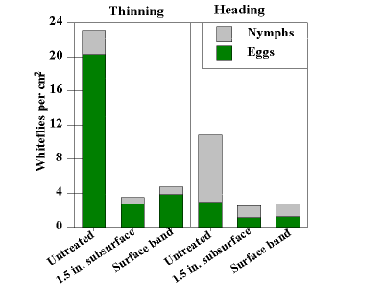Kerns, D.L. and J.C. Palumbo. 1995. Using Admire on Desert Vegetable Crops . IPM Series 5. Publ. No. 195017. University of Arizona, College of Agriculture and Life Sciences, Cooperative Extension, Tucson, Arizona. URL: http://cals.arizona.edu/crops/vegetables/insects/wf/admire.html
Chemical Properties
AdmireTM is a new insecticide developed by Bayer and is available for use in Arizona for control of certain pests in cotton, cole crops, lettuce, leafy greens, potatoes, and melons. AdmireTM is systemic and is highly active against aphids and whiteflies when taken up by the plant's roots. AdmireTM's common name is imidacloprid and was tested under the name NTN 33893. It is formulated as a flowable and contains 2.0 lbs-active ingredient per gallon of material.
AdmireTM belongs to a new class of insecticide called the chlornicotynls. Its mode of action is unique from any insecticides currently available for use in field crops and vegetables. AdmireTM is a nicotine mimic and acts by binding to the nicotinic receptor, thus simulating the action of acetylcholine. This action results is continual stimulation of the nerve cells and eventual death of the insect.
AdmireTM is very sensitive to ultra-violet light and has a half-life of about four hours in direct sunlight. Thus it should be applied soon after mixing. AdmireTM undergoes microbial degradation in the soil and has a soil half-life of <150 days. In the soil, it is not very mobile, particularly in heavy soils with high cation exchange capacities.
Lettuces and Cole Crops
AdmireTM is recommended for use in head and leaf lettuce, mustard, collards and cole crops for control of sweetpotato whitefly (strain-B), Bemisia tabaci and aphids. AdmireTM can be applied to these crops at 10 to 24 fluid ounces per acre. Application techniques labelled include: sub-seed furrow injection, in-furrow spray, transplant injection, soil-surface band, sidedress, post-seeding or pre-transplant drench, or through drip or trickle irrigation systems. Research at The University of Arizona has demonstrated that optimal performance of AdmireTM greatly depends on placement at the soil-root interface. The key to obtaining successful performance with AdmireTM is to place the product where it will stay in an aqueous solution within the root zone of the plant. For lettuces and cole crops there are three techniques that have demonstrated good efficacy for AdmireTM with minimal mechanical crop damage. Although lettuce and cole crops differ in root morphology, both crop types tend to concentrate their root mass within the frame area of the plant. Sub-seed furrow applications of AdmireTM have been shown to be very effective when injected into the soil 1.5 to 3.0 inches below the seed line just prior to planting (Figure 1).

below the seed line in the moisture area of the root zone.
For transplanted cauliflower, AdmireTM has demonstrated efficacy when injected into the soil into or just below the zone where the transplant plug will be placed and the cauliflower's roots will be concentrated. Soil-surface banded applications of AdmireTM have been shown to be extremely effective on direct-seeded lettuce. Applications should be applied as a 2.0 to 3.0 inch band over each seed line preemergence to the crop. The material should be hydrologically incorporated within 24 hours of application using overhead sprinkler irrigation. University research has shown that soil-surface banded applications that were not incorporated with sprinkler irrigation but irrigated via furrow irrigation did not provide adequate efficacy.
Side-dress applications of AdmireTM to spring lettuces have given inconsistent aphid control in university trials. Most of the problems with side-dress applications are associated with placing the material within the root zone without pruning the roots, or hydrologically moving the material into the plant's root zone. At present, The University of Arizona does not recommend side-dressing of AdmireTM in lettuce or cole crops.
Growers can expect to obtain 30 to 50 days control of whiteflies using these recommended techniques with labelled rates. On spring lettuce and cole crops, AdmireTM has also demonstrated superior efficacy controlling aphids. Application techniques for aphid control are similar to those used for fall grown produce. However, keep in mind that soil-surface banded applications of AdmireTM require over head sprinkler irrigation for adequate incorporation of the product. AdmireTM has provided up to 100 days control of green peach aphid, Myzus persicae in lettuce. Although winged forms may still be found infesting AdmireTM treated plants, they do not colonize.
Melons (cantaloupes and watermelons):
AdmireTM has a Section 18 emergency use exemption for use on melons for whitefly control. The current Section 18 for AdmireTM expires June 9, 1996. As with lettuce and cole crops, AdmireTM has been shown to effectively control whiteflies when injected at 16 fluid ounces per acre (80 inch rows) 3.0 inches below the seed line (sub-seed furrow) just prior to planting. In commercial settings AdmireTM has been effective at controlling whiteflies when applied through a low pressure drip irrigation system.

and surface band applications of AdmireTM at thinning and heading.
When applying through a drip system, it is important that the emitters are positioned to deliver the material at the base of the plant to optimize root uptake. Inject AdmireTM during a normal irrigation timing and allow the material to uniformly distribute across to the last emitters before terminating injection. Terminate injection as soon as the AdmireTM has cleared the last emmiter.
Because whitefly pressure can be especially intense on fall grown melons, The University of Arizona does not recommend use of AdmireTM on melons planted between May 1 and October 1 at elevations below 700 feet without augmenting control with foliar adulticides.
Application Volume
Although little research has been conducted regarding optimal application volume for maximum AdmireTM activity, volumes of 5 to 20 gallons per acre have proven effective for sub-seed furrow applications and 10 to 20 gallons per acre for soil surface banded applications.

band applications of AdmireTM.
Monitoring Field Performance
Research conducted at The University of Arizona Yuma Valley Agricultural Center clearly shows the benefits of using sub-seed furrow and surface banded applications of AdmireTM for whitefly control in lettuce (Figure 2). The effects of controlling whiteflies on lettuce correspond closely with increased head weight and diameter (Figure 3). Additionally, controlling whiteflies on lettuce prevented the yellowing normally observed on untreated plants. On broccoli and cauliflower, whitefly control increased yields by preventing delayed crop maturity and stem "blanching" associated with the presence of whiteflies.
Although AdmireTM has demonstrated increased yields in lettuce, cole crops and melons through whitefly control, University of Arizona research has shown that AdmireTM does not increase yield in the absence of whiteflies. Thus, AdmireTM has no known plant growth regulator qualities.
Immediately after crop emergence, it is not uncommon to find adult whiteflies and eggs on treated plants, particularly on the cotyledons. This is not necessarily indicative of an insecticide or application failure, but rather a delay in uptake of the material. Once the plants reach the one to three leaf stage, activity should be evident. However, because adults whiteflies may continually migrate into the field, do not base control on adult densities. If many adult whiteflies are present on treated plants, look closely around the base of the plants for adult whitefly cadavers. Also gently tap the plants against the soil surface and note whether or not the dislodged adults are alive or dead, and closely check the leaf tissue with a hand lens for the presence of eggs and immatures. At thinning check the first couple of basal leaves. University of Arizona research has shown that plants treated with AdmireTM will generally have ten or fewer eggs, and five or fewer immatures, while untreated plants will have 20 to 80 eggs and 30 to 40 immatures (Figure 2). If plants treated with AdmireTM contain high numbers of eggs or immatures, alternative control measures should probably be taken. To date there have been no reported whitefly control failures with AdmireTM.
It is a good idea to maintain a small untreated area in every field treated with AdmireTM. These areas will provide growers and crop advisors with a check to evaluate how well the AdmireTM is performing as the season progresses.
Product Efficacy Management
Because of heavy reliance on AdmireTM for whitefly and aphid control on vegetables in the lower desert region of Arizona, sustaining product efficacy is of great concern.
Vegetable crops grown in the low desert area of Arizona where a multi-cropping system predominates can be categorized for risk of whitefly infestation on produce and melon crops.
Lettuce and Cole Crops
Low Risk: Crops planted in October or later when temperatures have receded and there is no significant source (i.e. alfalfa, cotton or melons) of whiteflies within a one mile radius.
High Risk: Crops planted in September, or later plantings that are near a significant whitefly source when temperatures are high.
Melons
Low Risk: Melons planted during early spring during cool temperatures.
High Risk: Late spring and fall plantings.
Alternative foliar sprays have proven effective for lettuce, cole crops and melons under low risk situations. In addition there are several product management strategies which should help alleviate imidacloprid selection pressure on whiteflies and maintain product efficacy on vegetable crops.
- Consider using foliar materials for whitefly control under low risk situations.
- If possible, avoid using any formulation of imidacloprid (AdmireTM or ProvadoTM) in cotton.
- If by the thinning and heading stages, whiteflies are building up on fall produce or fall melons, consider applying a non-imidacloprid foliar material to eliminate possible tolerant individuals.
- Avoid using AdmireTM after whitefly pressure subsides for aphid control in produce scheduled for harvest before aphid populations traditionally develop.
References
- Palumbo, J. C., D. L. Kerns and T. Hannan. 1995. Evaluation of AdmireTM soil treatments on colonization of green peach aphid and marketability of lettuce, In: College of Agriculture, 1994 - 1995 Vegetable Report, pp. 122-129 , Series P-100.
- Palumbo, J. C., A. Tonhasca and D. N. Byrne. 1994. Sampling plans and action threshold for whiteflies on spring melons. University of Arizona, Cooperative Extension 194021, Tucson. IPM Series No. 1.
- Palumbo, J. C. 1995. Yield and quality response in iceberg lettuce to whiteflies and imidacloprid. In: Silverleaf whitefly, 1995 supplement to the 5-year research and action plan. USDA-ARS 1995-2, June 1995.
- Palumbo, J. C. and C. A. Sanchez. 1995. Imidacloprid does not enhance growth and yield in cantaloupes in the absence of whitefly. In: College of Agriculture, College of Agriculture, 1994 - 1995 Vegetable Report, pp. 115-121 , Series P-100.
- Palumbo, J. C., C. H. Mullis and F. J. Reyes. 1992. Evaluations of imidacloprid for control of aphids in broccoli. In: College of Agriculture, 1992 Vegetable Report, pp. 89-91, Series P-93.
Issued in furtherance of Cooperative Extension work, acts of May 8 and June 30, 1914, in cooperation with the U.S. Department of Agriculture, James A. Christenson, Director Cooperative Extension, College of Agriculture and Life Sciences, The University of Arizona.
The University of Arizona is an equal opportunity, affirmative action institution. The University does not discriminate on the basis of race, color, religion, sex, national origin, age, disability, veteran status, or sexual orientation in its programs and activities.
Any products, services, or organizations that are
mentioned, shown, or indirectly implied in this web document do not imply
endorsement by The University of Arizona.
Information provided by:
David L. Kerns, dkerns@ag.arizona.edu Associate Specialist (Entomology)
John C. Palumbo, jpalumbo@ag.arizona.edu Associate Research Scientist (Entomology)
University of Arizona, Tucson, Arizona.
Material written December 1995.
Vegetable Insects | Vegetable Insect Pubs | Vegetable Insect Data | Advisories | Pesticides | Photos
Home | Vegetables | All Insects
document located at: http://cals.arizona.edu/crops/vegetables/insects/wf/admire.html
Copyright © 2001 University of Arizona,
College of Agriculture and Life Sciences
webmaster: jsjones@ag.arizona.edu